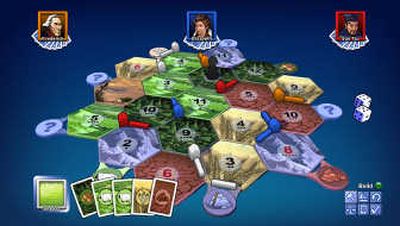Traditional board games get a digital upgrade

With board games dating back thousands of years, it makes sense that video game designers would copy their predecessors. Just about any board game you can name – from chess to Trivial Pursuit – has probably been translated into an electronic version.
Sometimes the influence of board games is less obvious. Real-time strategy games like “Age of Empires” are souped-up versions of Risk or Stratego. “SimCity” owes a debt to Monopoly, while “The Sims” has roots in The Game of Life. You could probably even draw a plausible connection between “Pac-Man” and Hungry Hungry Hippos.
Nintendo’s “Mario Party” series shows the influence most openly, mixing digitized board games with fast-paced arcade challenges. It has become one of Nintendo’s flagship franchises and a reliable option any time you need a game the whole family can play.
““Mario Party 8” (Nintendo, for the Wii, $49.99): At first glance, “Mario Party 8” looks like the perfect game for the Wii, a console designed for multiplayer mayhem. Unfortunately, it doesn’t take full advantage of the Wii’s motion-sensing remote, so the action never gets as physical as you would hope.
As usual, the party goes down on a variety of boards, ranging from a simple straight line (really) to a more satisfying hotel-building romp. Landing on certain squares leads to a simple action game in which you use the remote to row a boat, twirl a lasso, swing a bat or any of dozens of other tasks. There are some fun minigames to be found, but overall the control isn’t as precise as it should be, and the challenges don’t demonstrate the level of creativity seen in Nintendo’s earlier “WarioWare: Smooth Moves.”
Board game vets will also find it frustrating that “Mario Party 8” depends very heavily on luck; nothing’s worse than losing all your money because of a bad die roll. That probably helps balance the game between players of different experience levels, but having fortunes change so quickly dulls the game’s momentum. Rating: Two-and-a-half stars out of four.
““Tamagotchi Party On!” (Namco Bandai, for the Wii, $39.99): You may remember the Tamagotchi fad of the late 1990s; if you’re in your 20s you may have carried around one of the “digital pets” in its egg-shaped key chain. While Bandai has tried to keep the brand alive, most of us have moved on to “Nintendogs.”
“Party On!” plunks the critters down in another board game sprinkled with arcade minigames. The selection of challenges, though, is much smaller than that in “Mario Party,” and it’s possible to go a number of rounds without playing a single minigame. If you do land on one, you’ll find that only one person can play at a time. The games are so lackluster and the controls are so inadequate, however, that that may be a blessing.
“Party On!” is illustrated in a deliberately naJive style meant to evoke kids’ drawings. In execution, it’s the ugliest thing that’s popped up yet on the Wii. One-half star.
““Catan” (Microsoft, for the Xbox 360, $10): Aficionados know that the best new board games are coming from Germany. “The Settlers of Catan” was the first to find some success abroad, and now Microsoft has added a digital version to Xbox Live Arcade.
Each numbered space on the “Catan” board contains one of five resources – wood, brick, wool, wheat or ore – that you need to build roads, settlements and cities. To extract a resource you must have a settlement near it, and then you have to roll its number on a pair of dice. Points are awarded for each upgrade, and the first player to 10 wins.
Sound dry? It is, especially if you’re used to playing “Gears of War.” But it’s also really addictive, with a lot of the fun coming from the back-and-forth trading with your rival players. It’s nice to see Microsoft offering this kind of pure strategy game on Xbox Live. Three stars.